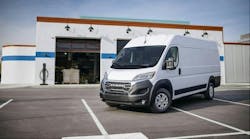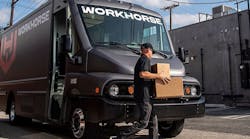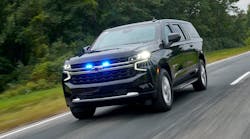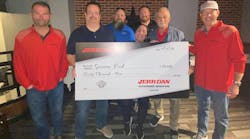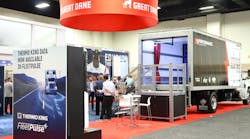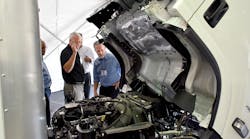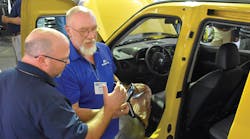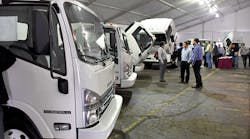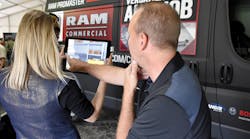General Motors is expanding its portfolio of Low Cab Forward (LCF) trucks with the 2018 Chevrolet 6500XD, a new dock-height Class 6 model.
Production will start this month at the company’s assembly plant in Charlotte, Michigan, where the other LCF trucks are made. This comes after the 2016 announcement that Chevrolet was returning to the medium-duty truck market and would offer six LCF medium-duty trucks through a GM-Isuzu partnership.
The 6500XD adds extra capability, including:
• Standard equipment includes a 5.2-liter four-cylinder turbodiesel that delivers 520 lb-ft of torque, an Allison 2500 Series 6-speed automatic transmission (with PTO), Dana axles, and a robust straight-rail frame.
• Front and rear axle ratings are 12,000 lbs and 19,000 lbs, respectively. Maximum GVWR is 25,950 lbs—enough capability to haul heavy machinery. (The key to the 6500XD is that because it’s under 26,000 lbs, a commercial driver’s license is not required to operate it.)
• Eight wheelbases are available and bodies up to 30 feet long can be accommodated.
GM’s LCF dealers and Upfitter Integration Group will work hand-in-hand with customers and their upfitters to spec the right truck for the job. After the sale, GM says its dealers will be there to support customers with extended service hours and work-ready loaners.
GM’s Upfitter Integration Group provides technical assistance to upfitters and serves as a liaison between Special Vehicle Manufacturers, end customers and several of GM’s engineering, marketing and service teams. They also maintain a website that includes detailed body builder manuals, technical bulletins and best practice manuals.
This product offensive includes new CNG and LPG propulsion options and an industry-leading 20 diesel-powered cars, crossovers, vans and pickups, all of which are compatible with B20 biodiesel.
GM is also expanding its suite of driver connectivity and fleet management solutions for small businesses and fleet managers. Last March, the company announced that it would add Spireon to its roster of telematics service providers, joining Telogis and GM’s own Commercial Link tool.
On the LCF models, here are the things to consider when upfitting, according to Paul Loewer, medium-duty product manager:
• Diesel emission devices. No-modification zones include the DEF tank, DEF lines, coolant lines, and exhaust aftertreatment. Emission compliance and warranty prohibit any modification to these systems.
• Diesel coolant lines. All Chevy LCF diesel trucks with MY2016 and after emissions use engine coolant heat to meet DEF thaw guidelines. Auxiliary heaters may not draw heat from engine coolant. Energy used for auxiliary heating may increase DEF thaw times beyond acceptable guidelines. Auxiliary heaters must include a self-contained heat source.
• Special bolt placement due to emissions system. Reinforcement block with U-bolt on left-hand chassis rail. Body-mounting bracket on right-hand chassis rail. Traditional U-bolt with wood reinforcement other locations.
• J-hook body mounts. LCF frames are not designed for J-hook mounting. This style of mounting may cause frame deformation and will void the frame warranty.
• Body builder connector. Located at the end of the frame. Packard four-pin weather connector: A, marker lamps; B, hot wire; C, rear dome; and D, ground.
• Dome lamp switch. A factory switch is available for rear body dome lamp application, with 15A fused circuit. Space “C” on rear of frame body builder connector. Three installed options: Port-Installed Option (PIO); dealer-installed; and body company-installed.
• Backup alarm connector. Located near the last crossmember at left-hand frame rail. Two-pin connector: A, ground; and B, BU alarm supply voltage.
Loewer provided the changes for 2018MY 6L LCF gas models:
• Adopt new ABS unit. Current unit was discontinued. Unit, bracket, and brake lines change, and there are minor harness and software changes
• New ECM. Change to ECM/TCM software/calibration. New MAF sensor. Hose routing was changed.
• Add Brake Apply Sensor (BAS). New ECM requires BAS to support OBD requirements. It is wired to the ECM only. The current brake switch will be used to support brake lamp operation and will be wired to the PIM to support GMLAN signals.
• Enhanced Electronic Pedal Override (EEPO). EEPO implemented to meet safety strategy for US market vehicles. GM has implemented EEPO for all North American applications, enabled with the new ECM software. When EEPO is active, the ECM calibration will limit torque output.
• Park brake alarm. Previous model years only had a BRAKE warning lamp. Now, a chime and indicator light will be activated if the parking brake is on and the operator attempts to move the vehicle.
Loewer provided the changes for 2018MY 3L and 2019MY 5.2L diesel models:
• New brake switch location. The location was changed to reduce interference. The 5500HD/XD has a protective cover due to a different brake booster system.
Dan Tigges, product manager for full-size pickups, said a rear camera is standard on all pickups for 2018MY. For the Silverado and Sierra, box deletes and chassis cabs continue to be pre-wired to the rear of the vehicle. For the Colorado and Canyon, they are pre-wired on the left side behind the wheel. The upfitter installs a GM or aftermarket camera. Calibration is required so the truck recognizes a camera is present. Camera installation details are available in Upfitter Integration Bulletin 127.
Colorado and Canyon now have a smart tow feature that enhances the driver’s rearward vision for towing. A center guideline activates when in reverse and the tow haul mode is selected. The image remains momentarily when moving forward to check hitch connection.
The Silverado and Sierra HD now have DPF manual regeneration in addition to the standard regeneration process. It allows the driver to force a stationary regeneration when the DPF requires it. It’s available for fleet customers only and is standard on emergency vehicles with emergency vehicle emissions.
Jonna Hudson, product manager for mid-size trucks and vans, said the 2018 Express/Savana have the following changes:
• Base vehicle was updated with up-level headlamps and new grill treatment.
• Rear-vision camera becomes standard on all models 10,000 lbs and under.
• OnStar is standard on all vans.
• New security bar with side windows on cargo vans.
• New 4.3L V6 base engine, replacing the 4.8L V8.
• Optional side blind zone alert.
• Hill start assist.
Hudson said the 2018 Cutaway has these revisions:
• Electronic Stability Control (Stabilitrak) is being added to all dual rear wheel Cutaways.
• The C7A 10,000-lb GVWR duel rear wheel Cutaway will be made available on the 139 and 159 now that Stabilitrak is standard.
• The rear backup camera kit will be standard on all Cutaways 10,000 lbs and under.
Click "Related Link" to continue reading NTEA 2017 Truck Product Conference coverage
